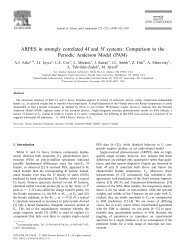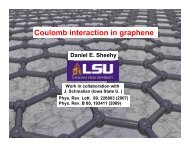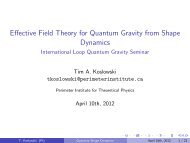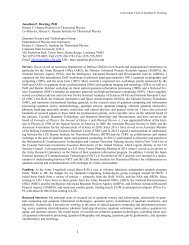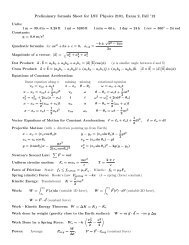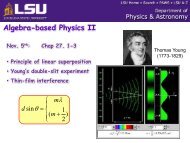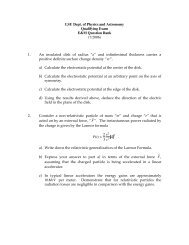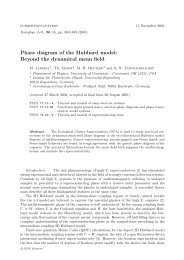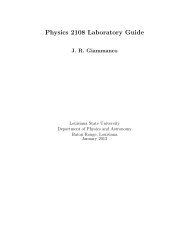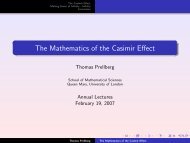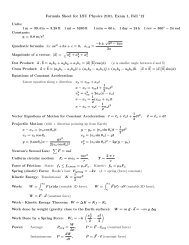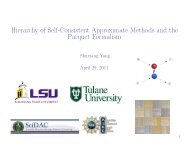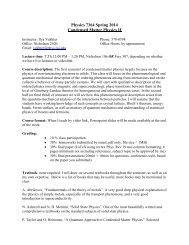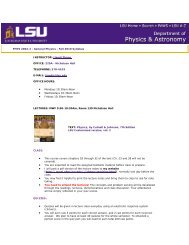1.(lOpts) A car travels 20 kilometers at an average speed of 80 km/h ...
1.(lOpts) A car travels 20 kilometers at an average speed of 80 km/h ...
1.(lOpts) A car travels 20 kilometers at an average speed of 80 km/h ...
- No tags were found...
You also want an ePaper? Increase the reach of your titles
YUMPU automatically turns print PDFs into web optimized ePapers that Google loves.
<strong>1.</strong> (<strong>lOpts</strong>) A <strong>car</strong> <strong>travels</strong> <strong>20</strong> <strong>kilometers</strong> <strong>at</strong> <strong>an</strong> <strong>average</strong> <strong>speed</strong> <strong>of</strong> <strong>80</strong> <strong>km</strong>/h <strong>an</strong>d then stops for15 minutes to get fuel. It then continues on in the same direction for <strong>20</strong> <strong>kilometers</strong> <strong>at</strong> <strong>an</strong><strong>average</strong> <strong>speed</strong> <strong>of</strong> 40 <strong>km</strong>/h in the same direction. The <strong>average</strong> <strong>speed</strong> <strong>of</strong> the <strong>car</strong> for this 40<strong>km</strong> trip is about:(a) 40 <strong>km</strong>/h(b) 45 <strong>km</strong>/h(c) 48 <strong>km</strong>/h(d) 53 <strong>km</strong>/h(e) 60 <strong>km</strong>/h2. (IOpts) Consider the two vectors A = 5f + 4] <strong>an</strong>d B = -3f + 10].Wh<strong>at</strong> is the magnitude <strong>of</strong> C = A - B?(a) 2.3(b) 7(c) 9(d) 10(e) 15.4(Use this inform<strong>at</strong>ion for Problems 3 <strong>an</strong>d 4)A model rocket is fired vertically from ground level, starting from rest. It ascends with avertical acceler<strong>at</strong>ion <strong>of</strong> 5 mls2 for 10.0 s. Its fuel is ~~n exhausted, so it continuesupward as a free-fall particle <strong>an</strong>d then falls back down to the ground.3. (5pts) Wh<strong>at</strong> is the <strong>speed</strong> <strong>of</strong> the rocket when the fuel runs out?(a) lOOmis(b) 50 mls(c) 5 mls(d) -9.8 mls(e) zero4. (<strong>lOpts</strong>) Wh<strong>at</strong> is the <strong>speed</strong> <strong>of</strong> the rocket 13 s after launch?(a) zero(b) 9.8 mls(c) <strong>20</strong>.6 mls
(d) 50 m/s(e) not enough inform<strong>at</strong>ion given5. (<strong>lOpts</strong>) How far does the runner, whose velocity-time graph is shown below, travelbetween t = 8s <strong>an</strong>d t = 16s?(a) 64m(b) 46 m(c) 44 m(d) 32 m(e) 10 m4 8Time (s)6. (5pts) A 10 kg block is allowed to slide down a long frictionless incline. The <strong>an</strong>gle <strong>of</strong>the incline is e = 30 deg. If it starts from rest, wh<strong>at</strong> will its <strong>speed</strong> be after sliding <strong>1.</strong>63 malong the incline?(a) zero(b) <strong>1.</strong>5 m/s(c) 3.3 m/s(d) 9.8 m/s(e) 4.0 m/s7. (5pts) A football is thrown <strong>at</strong> <strong>an</strong>gle <strong>of</strong> 50 deg into the air. Which st<strong>at</strong>ement below istrue about the highest point <strong>of</strong> the football's motion?(a) The football's <strong>speed</strong> is zero.(b) The horizontal component <strong>of</strong> football's velocity is zero.(c) The vertical component <strong>of</strong> football's velocity is zero.(d) The football's acceler<strong>at</strong>ion is zero.(e) The magnitude <strong>of</strong> the football's vertical <strong>an</strong>d horizontal velocities are the same.
(Use this inform<strong>at</strong>ion for Problems 8, 9, <strong>an</strong>d 10)Block A in the figure below has mass mA = 8.0 kg <strong>an</strong>d is sliding down the ramp. Block Bhas mass ms = 4.0 kg. The coefficient <strong>of</strong> kinetic friction between blockB <strong>an</strong>d thehorizontal pl<strong>an</strong>e is 0.50. The inclined pl<strong>an</strong>e is frictionless <strong>an</strong>d <strong>at</strong> <strong>an</strong>gle 30°.8. (5pts) Wh<strong>at</strong> is the frictional force on ms?(a) 19.6 N(b) 39.2 N(c) 5.3 N(d) zero(e) its equal to the tension in the stringFnctionle sme.siess pulley-9. (<strong>lOpts</strong>) Wh<strong>at</strong> is the magnitude <strong>of</strong> the acceler<strong>at</strong>ion <strong>of</strong> the blocks?(a) 9.8 m/s2. (b) 5.2 m/s2(c) 3.3 m/s2(d) <strong>1.</strong>6 m/s2(e) it c<strong>an</strong>'t be determined without further inform<strong>at</strong>ion10. (5pts) Wh<strong>at</strong> is the tension in the string connecting the blocks?(a) 39.2 N(b) 30.1 N(c) 26.1 N(d) 19.6 N(e) 13.1 N(Use this inform<strong>at</strong>ion for Problems 11 <strong>an</strong>d 12)In the figure below, a stone is projected <strong>at</strong> a cliff <strong>of</strong> height h ='60 m with <strong>an</strong> initial <strong>speed</strong><strong>of</strong> 75.0 m/s directed 60.0° above the horizontal.1<strong>1.</strong> (<strong>lOpts</strong>) When does the stone strike the top <strong>of</strong> the cliff?(a) 12.3 s(b) 9.8 s(c) 4.3 s(d) <strong>1.</strong>0 s(e) 0.5 s
12. (5pts) Wh<strong>at</strong> is the <strong>speed</strong> <strong>of</strong> the stone just before it hits the cliff?(a) zero(b) 9.8 m/s(c) 55 m/s(d) 67 m/s(e) 38 m/s13. (5pts) An astronaut on the space st<strong>at</strong>ion whirls a 0.5 kg mass <strong>at</strong>tached to a string in acircle <strong>of</strong> radius <strong>1.</strong>6 m. If the <strong>speed</strong> <strong>of</strong> the mass is 8 mIs, wh<strong>at</strong> is the tension in the string?(a) 64 N(b) 32 N(c) <strong>20</strong> N(d) 4.9 N(e) none <strong>of</strong> the above14. (5pts) Two forces are applied to a 2 kg object flo<strong>at</strong>ing out in space. One force has amagnitude <strong>of</strong> <strong>20</strong> N <strong>an</strong>d the other has magnitude <strong>of</strong> 30 N. Which <strong>of</strong> the followingrepresent the minimum <strong>an</strong>d maximum <strong>of</strong> the possible acceler<strong>at</strong>ion th<strong>at</strong> the object c<strong>an</strong>have, depending on the rel<strong>at</strong>ive directions <strong>of</strong> the two forces? (consider magnitudes only)(a) 0.0 m/S2, 15 m/s2(b) 0.0 m/S2, 10 m/s2(c) 2.1 m/S2, 4.4 m/s2(d) 5.0 m/S2, 25.0 m/s2(e) 0.0 m/S2, 8.3 m/s2
2axt 1 2Units:1m = 39.4in = 3.28ft1<strong>at</strong>m = <strong>1.</strong>013x 105PaFormula Sheet for LSD Physics 2101 Exams, Fall '09Imi = 52<strong>80</strong>ft1cal = 4.187JConst<strong>an</strong>ts:g = 9.8m/s2G = 6.67xl0-ll m3/(kg·s2)Earth-Sun dist<strong>an</strong>ce = <strong>1.</strong>50X 1011mk = <strong>1.</strong>38 X 10-23 J /KProperties <strong>of</strong> H<strong>20</strong>:Density:Specific he<strong>at</strong>:He<strong>at</strong>s <strong>of</strong> tr<strong>an</strong>sform<strong>at</strong>ion:Equ<strong>at</strong>ions <strong>of</strong> Const<strong>an</strong>t Acceler<strong>at</strong>ion:linear equ<strong>at</strong>ion tmissing() w0:Wo- ()oalong xX-Xo missing Vox ax Vx tX - Xo -even; + vx)tX - Xo = vxt - -axt22 v~X -= Xo v~x = + ven;t 2ax(x + -axt - xo)Pw<strong>at</strong>erlmin = 60s,1day = 24hT = (~o~)Tc + 273.15KREarth = 6.37 X 106 mRMoon = <strong>1.</strong>74 X 106 mMSun = <strong>1.</strong>99xl03o kgR = 8.31J/(mol·K)= 1000 kg/m3MEarth = 5.98xl024kgMMoon = 7.36x 1022 kgEarth-Moon dist<strong>an</strong>ce = 3.82x108 mAvogadro's # = 6.02 xI023partic1es/molCw<strong>at</strong>er = 4187 J/(kg K) Cke = 22<strong>20</strong> J/(kg K)Lvaporiz<strong>at</strong>ion = 2.256 X 106 J/kg Lfusion = 3.33 X 105 J /kg-b± Vb2 - 4acQuadr<strong>at</strong>ic formula: for ax2 + bx + c = 0, Xl 2 = -------. ' 2aMagnitude <strong>of</strong> a vector: lal = Ja; + a~ +a;Dot Product: a· 6 = axbx + ayby + azbz = lal161 cos(¢) (if; is smaller <strong>an</strong>gle between ii <strong>an</strong>d b)Cross Product: a x 6 = (aybz - azby)i + (azbx - axbz)j + (axby - aybx)k, la x 61 = lallbl sin(¢)rot<strong>at</strong>ional equ<strong>at</strong>ionw = Wo + O:xt1 2() - ()o = wot + -o:t2w2 = w~ + 2o:«() - ()o)1() - ()o = -Cwo + w)t2 1() - ()o = wt - -o:t221Vector Equ<strong>at</strong>ions <strong>of</strong> Motion for Const<strong>an</strong>t Acceler<strong>at</strong>ion: .~=ro+ vot + -<strong>at</strong>2, v = Vo+ <strong>at</strong>2Projectile Motion: (with + direction pointing up from Earth)1 2X - Xo = (vocos()o)t y - Yo = (vo sin ()o)t - -gt2Vx = Vo cos ()o vy = (vo sin ()o) - gtgx2v~ = (vo sin ()0)2 - 2g(y - Yo) y = (t<strong>an</strong> ()o)x - 2( Vo cos ()o )2Newton's Second Law: 2:F = mamv2Uniform circular motion: Fe = -- = maer27rrT=-VForce <strong>of</strong> Friction: St<strong>at</strong>ic: Is::; Is,rnax = J.LsFN, Kinetic: Ik = J.LkFNElastic (Spring) Force: Hooke's Law F = -kx (k = spring (force) const<strong>an</strong>t)1Kinetic Energy (nonrel<strong>at</strong>ivistic): Tr<strong>an</strong>sl<strong>at</strong>ional K = -mv22Work:v~ ·sin(2()0)R=----9-- W = F· d (const<strong>an</strong>t force), W = lxf Xi F(x)dx (variable I-D force), W = Jri rf F(r). - dr (variable 3-D force)Work - Kinetic Energy Theorem: W = t!&.K= K f - Ki where W is the net work



